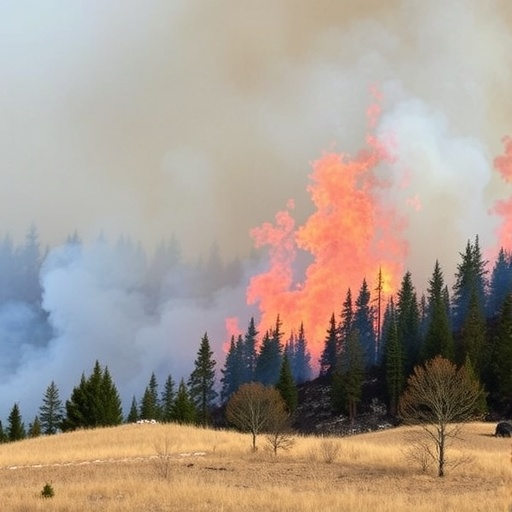The devastating effects of wildfires are undeniable. From the scorched remains of homes and forests to the irreparable loss of life and memories, the destructive aftermath often overshadows any potential silver linings. However, recent research from the University of Delaware reveals a hidden treasure within the charred remnants left behind by these infernos—a discovery that could play a pivotal role in combating climate change by reducing methane emissions, a potent greenhouse gas contributing significantly to global warming.
At the heart of this groundbreaking research is Pei Chiu, a professor of civil, construction, and environmental engineering at the University of Delaware. His work revolves around wildfire char—the charcoal-like residue formed when biomass burns during wildfires—and biochar, its anthropogenic counterpart produced through pyrolysis, a controlled heating process that converts agricultural residues and other biomass into carbon-rich char materials in oxygen-limited environments. This dual study of natural and manufactured char unveils unprecedented environmental applications, particularly in mitigating methane emissions.
Methane, a greenhouse gas approximately 85 times more effective at trapping heat than carbon dioxide over a 20-year period, originates from diverse sources such as livestock manure, landfills, and wastewater treatment plants. These environments often create oxygen-depleted conditions that foster the growth of methanogenic microbes producing methane as a metabolic byproduct. Chiu’s research reveals that wildfire chars and biochars could fundamentally alter this microbial dynamic by serving as alternative electron acceptors, effectively suppressing methane production.
Electron transfer is central to biological energy cycles. In human physiology, for example, electrons are shuttled from sugar molecules to oxygen to generate energy during respiration. When oxygen is scarce, the body resorts to fermentation, an anaerobic process producing less desirable byproducts. Microorganisms mirror this metabolic flexibility. In the absence of oxygen, certain microbes called methanogens proliferate, generating methane. Chiu’s investigations disclose that chars serve as electron reservoirs that microbes can “breathe,” facilitating respiration in oxygen-poor habitats and thereby outcompeting methanogenic organisms.
Chiu’s team has quantified the electron storage capacity (ESC) of these char materials, finding them capable of storing immense quantities of electrons. A mere gram, approximately a quarter teaspoon, of biochar or wildfire char can hold billions of trillions of electrons. With agriculture and forestry generating hundreds of millions of tons of biomass residues annually in the United States alone, the sheer scale of available char’s electron capacity is staggering, indicating vast potential for natural methane mitigation strategies.
Unlike carbon dioxide, which persists in the atmosphere for centuries, methane remains active for just under 12 years. This difference makes targeting methane reductions particularly urgent and impactful. The ability of wildfire chars and plant-based biochars to suppress methane production by sustaining char-breathing microbial communities offers a promising avenue for climate change mitigation that operates on meaningful contemporary timescales.
Historically, wildfire chars have been integral to the global carbon cycle for millions of years. It follows that microbial communities evolved mechanisms to metabolize these carbon-rich structures. This co-evolution suggests a natural, symbiotic interaction between char materials and soil microbes that could be harnessed to manage greenhouse gases sustainably, leveraging processes refined by nature over eons.
Beyond methane suppression, the implications of chars extend to contaminant dynamics. Microbes capable of utilizing chars for respiration also demonstrate the potential to immobilize toxic substances such as arsenic, thereby preventing contamination of drinking water and agricultural food chains. Furthermore, these microbes assist in removing nitrates and perchlorates from stormwater and groundwater, expanding the environmental utility of char beyond greenhouse gas management.
This research sheds light on a previously underappreciated electron-mediated process in soil and water biogeochemistry, inviting reconsideration of chars not merely as passive residues but as active, electron-rich participants in microbial ecosystems. Such insight paves the way for novel environmental engineering applications aimed at enhancing soil health, remediating polluted water, and reducing atmospheric methane simultaneously.
The sustainable aspect of this approach is compelling. Microbes that respire char do so repeatedly, meaning the same char material can function as an enduring electron reservoir. Unlike many chemical treatments that are transient or require continuous input, char-mediated methane suppression can persist, providing a long-term, renewable strategy embedded in natural microbial metabolism.
Chiu’s passion for this line of inquiry is fueled by the vast scale of the phenomena. The mathematical magnitude of electrons cycling through global biogeochemical processes every year, facilitated by chars, is almost unfathomable—amounting to numbers with 36 zeros. This immense scale underscores the untapped potential that chars hold, waiting to be understood and applied within environmental sciences and engineering.
While wildfires themselves are overwhelmingly destructive and present numerous risks, the discovery of beneficial properties within wildfire chars offers a hopeful narrative. It suggests that even in environmental disasters, nature provides mechanisms that, if understood and leveraged thoughtfully, can contribute to solving pressing challenges such as greenhouse gas emissions and contaminated water remediation.
The burgeoning field of char research invites multidisciplinary collaboration. Chemists, microbiologists, ecologists, and engineers alike are essential to deciphering the complex electron transfer processes, unraveling microbial metabolic pathways, and developing scalable applications that harness the power of chars. Future directions envision integrating biochar amendments in agricultural soils not only to enhance productivity but to mitigate methane emissions on a global scale.
This research exemplifies a shift from focusing solely on carbon dioxide to embracing a broader carbon cycle perspective with an emphasis on electron flow and microbial ecology. With the climate crisis intensifying, understanding and utilizing wildfire and biochars as natural tools for environmental stewardship could be transformative, fostering technologies embedded in the metabolic capacities of microbes and the resilience of ecosystems.
Subject of Research:
Electron storage capacity of wildfire char and biochar and their role in suppressing methane emissions through microbial respiration.
Article Title:
Potential of Wildfire Chars to Suppress Methane Emissions by Supporting Electron-Respiring Microbial Communities
Web References:
https://pubs.acs.org/doi/10.1021/acs.est.5c05709
References:
Chiu, P., Choi, J., Xin, D. (Year). [Article Title]. Environmental Science & Technology. DOI: 10.1021/acs.est.5c05709
Keywords:
Wildfire char, biochar, methane suppression, electron storage capacity, microbial respiration, greenhouse gases, climate change mitigation, soil amendments, biogeochemistry, pyrolysis, environmental engineering, contaminant remediation




